Abstract
The use of a collagenase dispersion technique has allowed us to compare size, histamine content and the secretory characteristics of mast cells from the mucosal and muscle layers of the human large intestine. Mast cells from the mucosa, which constituted 1.8% of the total nucleated cells, contained approximately equal numbers of formalin-sensitive and -insensitive mast cells. Those dispersed from the muscle layer constituted 3.2% of the total nucleated cells and were almost all formalin insensitive. The cells from both layers were similar with respect to size and mean cell histamine content. Anti-IgE released up to 15.1% and 16.5% of total cell histamine in the mucosa and muscle, respectively, with similar concentration-response characteristics. The kinetics of anti-IgE-induced release, however, were different, mucosal mast cells releasing histamine 55 seconds (P less than 0.05) faster than cells dispersed from intestinal muscle. Cells from both layers also released histamine in response to A23187 in a similar concentration-related fashion. Neither mucosal or muscle mast cells released significant amounts of histamine in response to compound 48/80, substance P, morphine, poly-L-lysine or f-met-leu-phe. Our results show intestinal mast cells possess secretory characteristics similar to those of human lung, adenoids and tonsils, but are different from human skin mast cells. The absence of significant histamine release in response to basic secretagogues from either layer of the human intestine contrasts with studies in the rodent intestine. Furthermore it suggests that in human mast cells, histochemical properties, protease content and secretory characteristics may not be closely associated.
Full text
PDF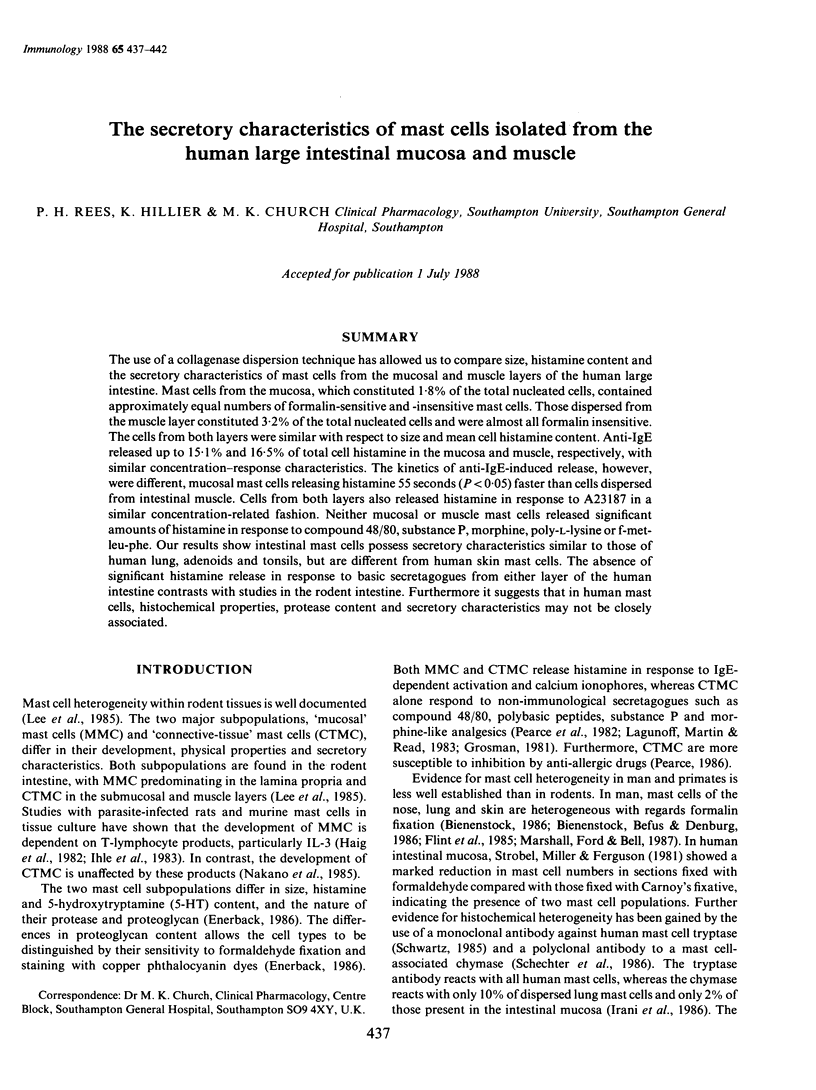

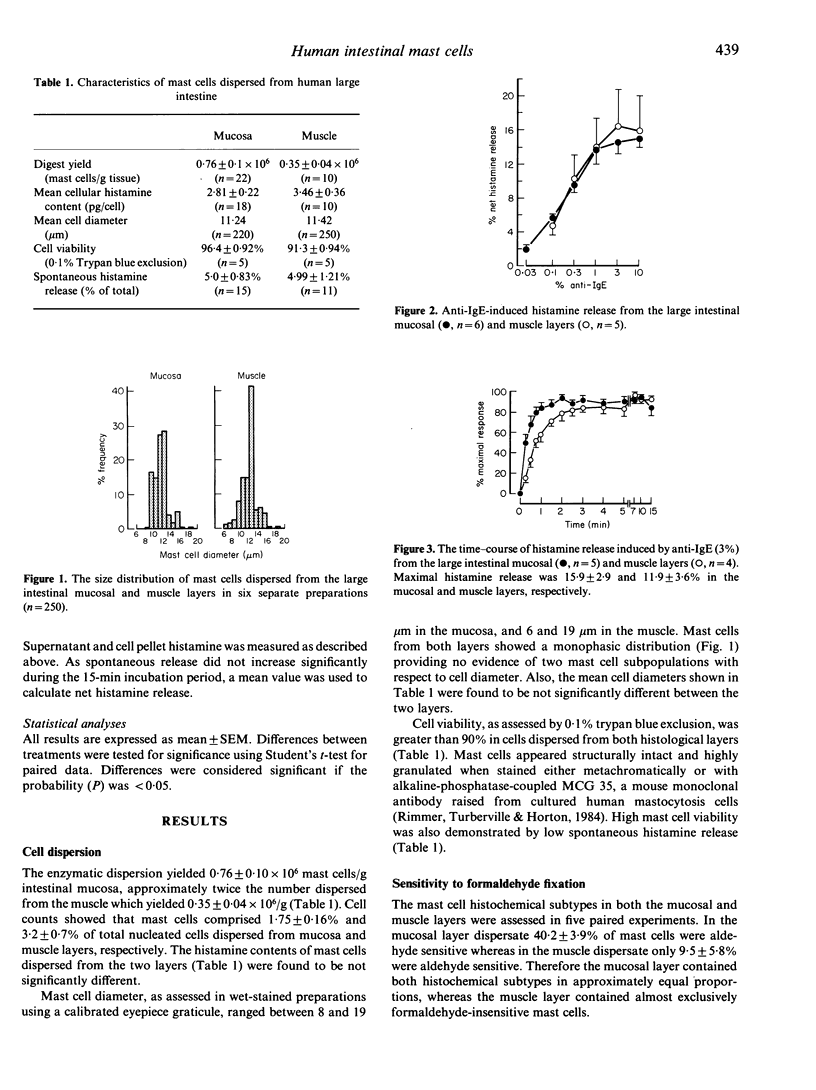
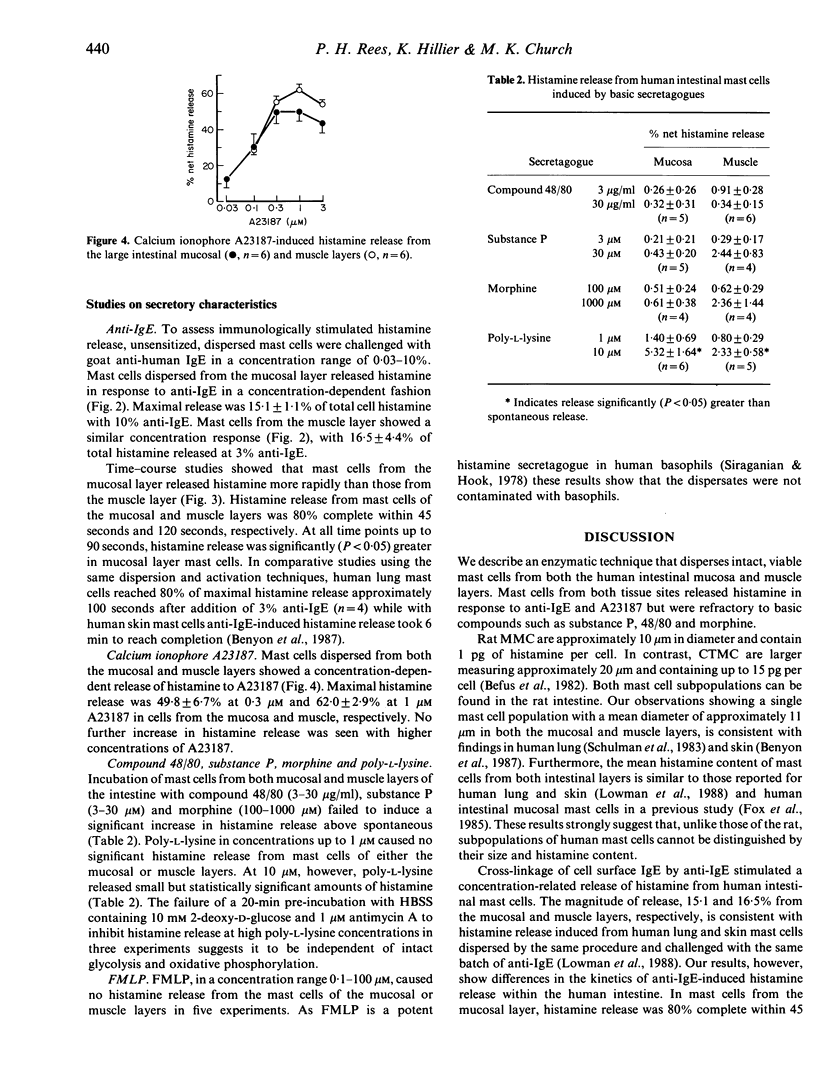
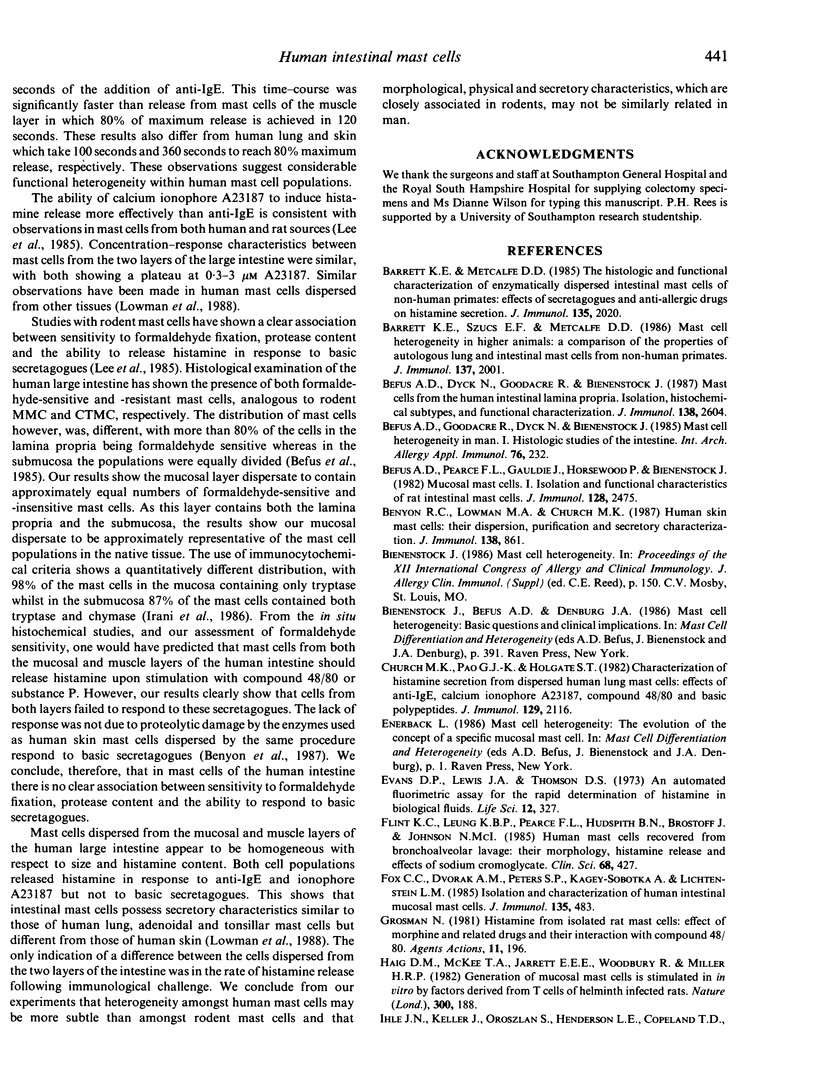
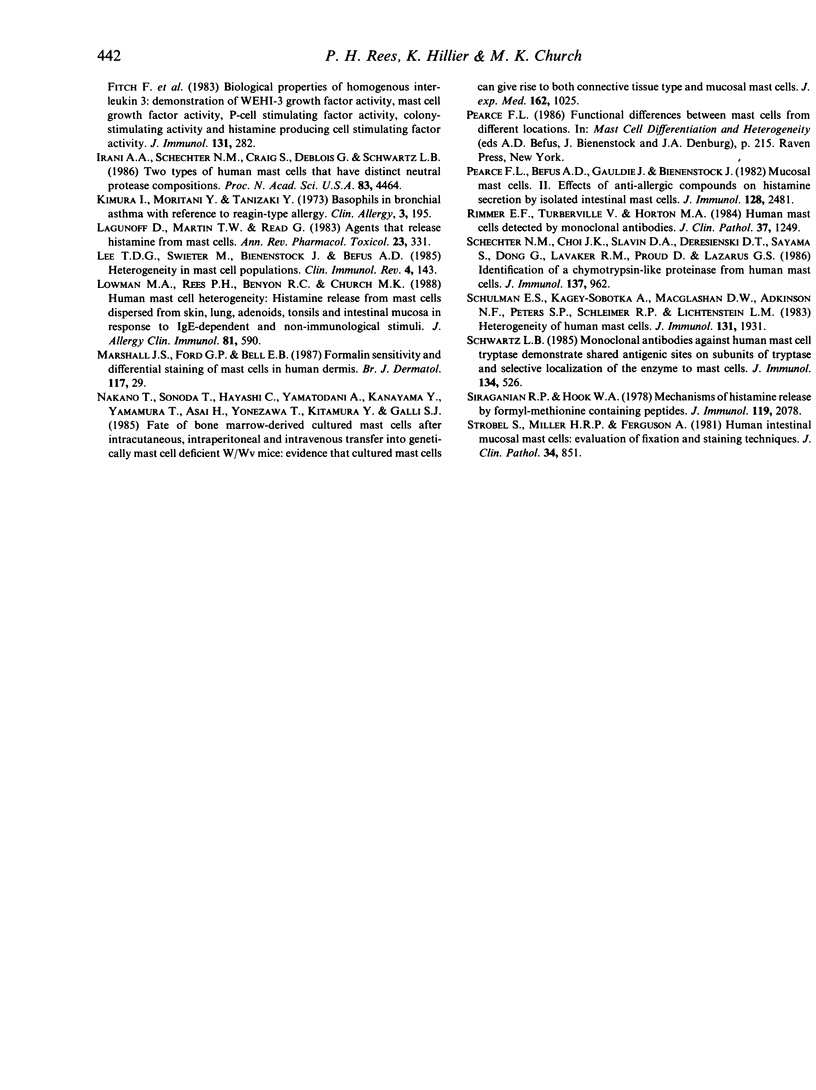
Selected References
These references are in PubMed. This may not be the complete list of references from this article.
- Barrett K. E., Metcalfe D. D. The histologic and functional characterization of enzymatically dispersed intestinal mast cells of nonhuman primates: effects of secretagogues and anti-allergic drugs on histamine secretion. J Immunol. 1985 Sep;135(3):2020–2026. [PubMed] [Google Scholar]
- Barrett K. E., Szucs E. F., Metcalfe D. D. Mast cell heterogeneity in higher animals: a comparison of the properties of autologous lung and intestinal mast cells from nonhuman primates. J Immunol. 1986 Sep 15;137(6):2001–2008. [PubMed] [Google Scholar]
- Befus A. D., Dyck N., Goodacre R., Bienenstock J. Mast cells from the human intestinal lamina propria. Isolation, histochemical subtypes, and functional characterization. J Immunol. 1987 Apr 15;138(8):2604–2610. [PubMed] [Google Scholar]
- Befus A. D., Pearce F. L., Gauldie J., Horsewood P., Bienenstock J. Mucosal mast cells. I. Isolation and functional characteristics of rat intestinal mast cells. J Immunol. 1982 Jun;128(6):2475–2480. [PubMed] [Google Scholar]
- Befus D., Goodacre R., Dyck N., Bienenstock J. Mast cell heterogeneity in man. I. Histologic studies of the intestine. Int Arch Allergy Appl Immunol. 1985;76(3):232–236. doi: 10.1159/000233697. [DOI] [PubMed] [Google Scholar]
- Benyon R. C., Lowman M. A., Church M. K. Human skin mast cells: their dispersion, purification, and secretory characterization. J Immunol. 1987 Feb 1;138(3):861–867. [PubMed] [Google Scholar]
- Church M. K., Pao G. J., Holgate S. T. Characterization of histamine secretion from mechanically dispersed human lung mast cells: effects of anti-IgE, calcium ionophore A23187, compound 48/80, and basic polypeptides. J Immunol. 1982 Nov;129(5):2116–2121. [PubMed] [Google Scholar]
- Evans D. P., Lewis J. A., Thomson D. S. An automated fluorimetric assay for the rapid determination of histamine in biological fluids. Life Sci II. 1973 Apr 8;12(7):327–336. doi: 10.1016/0024-3205(73)90366-4. [DOI] [PubMed] [Google Scholar]
- Flint K. C., Leung K. B., Pearce F. L., Hudspith B. N., Brostoff J., Johnson N. M. Human mast cells recovered by bronchoalveolar lavage: their morphology, histamine release and the effects of sodium cromoglycate. Clin Sci (Lond) 1985 Apr;68(4):427–432. doi: 10.1042/cs0680427. [DOI] [PubMed] [Google Scholar]
- Fox C. C., Dvorak A. M., Peters S. P., Kagey-Sobotka A., Lichtenstein L. M. Isolation and characterization of human intestinal mucosal mast cells. J Immunol. 1985 Jul;135(1):483–491. [PubMed] [Google Scholar]
- Grosman N. Histamine release from isolated rat mast cells: effect of morphine and related drugs and their interaction with compound 48/80. Agents Actions. 1981 May;11(3):196–203. doi: 10.1007/BF01967614. [DOI] [PubMed] [Google Scholar]
- Haig D. M., McKee T. A., Jarrett E. E., Woodbury R., Miller H. R. Generation of mucosal mast cells is stimulated in vitro by factors derived from T cells of helminth-infected rats. Nature. 1982 Nov 11;300(5888):188–190. doi: 10.1038/300188a0. [DOI] [PubMed] [Google Scholar]
- Ihle J. N., Keller J., Oroszlan S., Henderson L. E., Copeland T. D., Fitch F., Prystowsky M. B., Goldwasser E., Schrader J. W., Palaszynski E. Biologic properties of homogeneous interleukin 3. I. Demonstration of WEHI-3 growth factor activity, mast cell growth factor activity, p cell-stimulating factor activity, colony-stimulating factor activity, and histamine-producing cell-stimulating factor activity. J Immunol. 1983 Jul;131(1):282–287. [PubMed] [Google Scholar]
- Irani A. A., Schechter N. M., Craig S. S., DeBlois G., Schwartz L. B. Two types of human mast cells that have distinct neutral protease compositions. Proc Natl Acad Sci U S A. 1986 Jun;83(12):4464–4468. doi: 10.1073/pnas.83.12.4464. [DOI] [PMC free article] [PubMed] [Google Scholar]
- Kimura I., Moritani Y., Tanizaki Y. Basophils in bronchial asthma with reference to reagin-type allergy. Clin Allergy. 1973 Jun;3(2):195–202. doi: 10.1111/j.1365-2222.1973.tb01321.x. [DOI] [PubMed] [Google Scholar]
- Lagunoff D., Martin T. W., Read G. Agents that release histamine from mast cells. Annu Rev Pharmacol Toxicol. 1983;23:331–351. doi: 10.1146/annurev.pa.23.040183.001555. [DOI] [PubMed] [Google Scholar]
- Lee T. D., Swieter M., Bienenstock J., Befus A. D. Heterogeneity in mast cell populations. Clin Immunol Rev. 1985;4(2):143–199. [PubMed] [Google Scholar]
- Lowman M. A., Rees P. H., Benyon R. C., Church M. K. Human mast cell heterogeneity: histamine release from mast cells dispersed from skin, lung, adenoids, tonsils, and colon in response to IgE-dependent and nonimmunologic stimuli. J Allergy Clin Immunol. 1988 Mar;81(3):590–597. [PubMed] [Google Scholar]
- Marshall J. S., Ford G. P., Bell E. B. Formalin sensitivity and differential staining of mast cells in human dermis. Br J Dermatol. 1987 Jul;117(1):29–36. doi: 10.1111/j.1365-2133.1987.tb04087.x. [DOI] [PubMed] [Google Scholar]
- Nakano T., Sonoda T., Hayashi C., Yamatodani A., Kanayama Y., Yamamura T., Asai H., Yonezawa T., Kitamura Y., Galli S. J. Fate of bone marrow-derived cultured mast cells after intracutaneous, intraperitoneal, and intravenous transfer into genetically mast cell-deficient W/Wv mice. Evidence that cultured mast cells can give rise to both connective tissue type and mucosal mast cells. J Exp Med. 1985 Sep 1;162(3):1025–1043. doi: 10.1084/jem.162.3.1025. [DOI] [PMC free article] [PubMed] [Google Scholar]
- Pearce F. L., Befus A. D., Gauldie J., Bienenstock J. Mucosal mast cells. II. Effects of anti-allergic compounds on histamine secretion by isolated intestinal mast cells. J Immunol. 1982 Jun;128(6):2481–2486. [PubMed] [Google Scholar]
- Rimmer E. F., Turberville C., Horton M. A. Human mast cells detected by monoclonal antibodies. J Clin Pathol. 1984 Nov;37(11):1249–1255. doi: 10.1136/jcp.37.11.1249. [DOI] [PMC free article] [PubMed] [Google Scholar]
- Schechter N. M., Choi J. K., Slavin D. A., Deresienski D. T., Sayama S., Dong G., Lavker R. M., Proud D., Lazarus G. S. Identification of a chymotrypsin-like proteinase in human mast cells. J Immunol. 1986 Aug 1;137(3):962–970. [PubMed] [Google Scholar]
- Schwartz L. B. Monoclonal antibodies against human mast cell tryptase demonstrate shared antigenic sites on subunits of tryptase and selective localization of the enzyme to mast cells. J Immunol. 1985 Jan;134(1):526–531. [PubMed] [Google Scholar]
- Siraganian R. P., Hook W. A. Mechanism of histamine release by formyl methionine-containing peptides. J Immunol. 1977 Dec;119(6):2078–2083. [PubMed] [Google Scholar]
- Strobel S., Miller H. R., Ferguson A. Human intestinal mucosal mast cells: evaluation of fixation and staining techniques. J Clin Pathol. 1981 Aug;34(8):851–858. doi: 10.1136/jcp.34.8.851. [DOI] [PMC free article] [PubMed] [Google Scholar]


